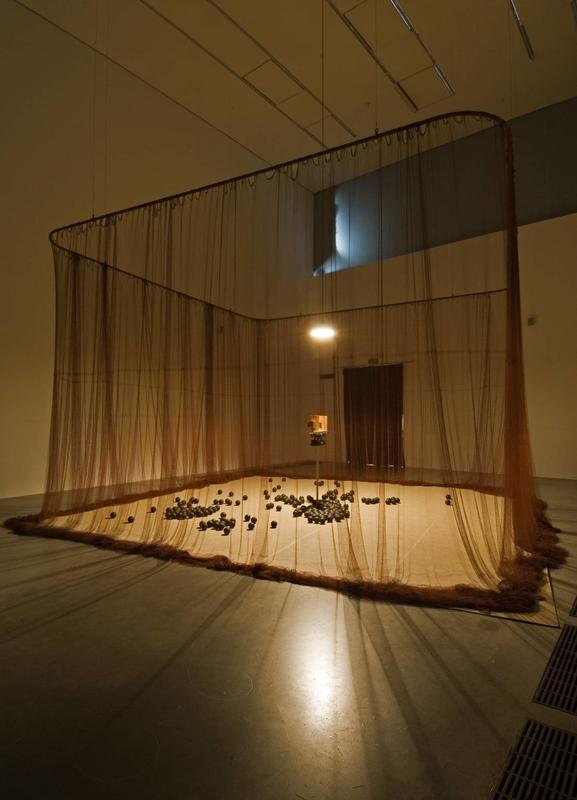More about Eureka/Blindhotland
- All
- Info
- Shop

Contributor
In Eureka/Blindhotland, which is more of an interactive environment or traveling circus tent in the artist's words, than a sculpture, Cildo Meireles takes on the role of a friend and teacher.
It often takes a friend or family member, someone who genuinely cares about you, to teach you about the paradoxes of life—not too long ago, your ancestors would have made a beeline for the nearest elder/spiritual leader in the community for the kind of wisdom that Meireles imparts in this work, which bridges the gap between allegory and performance. It's a performative work in the sense that your behavior as a spectator, engaging the senses of hearing and touch, is essential to it. When you first see it, you notice a large grouping of spheres sitting on the ground—201 of them—and your first assumption, colored by decades of life in consumer society, is that each sphere must be identical, because they look identical. They are made from the same material and have the same diameter, but each one has a different weight, between 150 and 1500 grams. Unless you've studied Meireles already, the only way to figure this out is by playing with the spheres and rolling them around.
How would our ancestors know that those little red delicious-looking berries are digestible only to birds, and not to us? Without the advice of an elder, how would we ever have known that sex, for example, under certain conditions, can lead to babies, and isn't always just a lighthearted cardio workout? An elder would have given us information regarding what they call "availability bias," or our bias toward assuming that the future will resemble the past in a linear way. Since we live in a society of mass production and hoarding of objects, which can be superfluous and identical in appearance, construction, mass, volume, or weight, we would tend to assume that the 201 spheres weigh the same. This is where Meireles got the idea to use the word "Blind" in this part of the title. He doesn't know where "hotland" came from, which gives his work a certain level of authenticity. "Eureka," apocryphally, is the exclamation of joy Archimedes used as he ran down some ancient Greek boulevard in his birthday suit.
Meireles chose the following epigraph for this work: "The first man is always a crowd." The first woman, too? Eureka/Blindhotland features a work-within-a-work, a soundtrack, entitled Expeso (Overweight). It's based on a Jorge Luis Borges story from 1940, “Tlön, Uqbar, Orbis Tertius.“
Sources
- Bedran, Marina. "Cildo para forjar outros mundos." El País, Mar. 12, 2018, https://brasil.elpais.com/brasil/2018/03/12/opinion/1520893671_060522.h….
- Domingos de Lima, Juliana. "Coma a obra de Cildo Meireles estimula o uso dos sentidos." Nexojornal, Sep. 24, 2019, https://www.nexojornal.com.br/expresso/2019/09/24/Como-a-obra-de-Cildo-….
- Fraga, Marina, and Pedro Urano. "CARBONO ENTREVISTA CILDO MEIRELES." Carbono, Aug. 2013, http://revistacarbono.com/artigos/04carbono-entrevista-cildo-meireles/.
- Martins, Sérgio B. Constructing an Avant-Garde: Art in Brazil, 1949-1979. Cambridge: MIT Press, 2013.
- Matos, Diego. "Eureka Blindhotland questiona sentido visual em 'Entrevendo: Cildo Meireles'." YouTube video, 3:44. Nov. 17, 2019, https://youtu.be/RbDWW0aPewU.
- Sullivan, Edward J. Arte Latinoamericano En El Siglo Xx/Latin American Art in the Twentieth Century. Madrid: Editorial NEREA, 1996.
- Wisnik, Guilherme, and Diego Matos. Cildo: Studies, spaces, time. São Paulo: Ubu Editora LTDA - ME, 2018.












